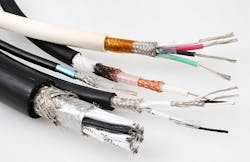Navy sends word out to industry for its need for nearly 12,000 feet of mil-spec shipboard cabling
Officials of the Naval Surface Warfare Center Crane Division in Crane, Ind., issued a solicitation last week (N0016415T0013) for M24643, M24640 and M16878 mil-spec cable for a variety of shipboard electrical and electronics applications.
M24640 cabling describes low-smoke halogen-free electric cable for Navy shipboard applications. These cables are significantly lighter in weight and smaller in diameter than those specified in the M24643 specification. M24640 cables are used to interconnect systems where weight and space savings are critical.
Related: Contractor protests could hold up Navy CANES shipboard networking program until December
M24643 describes cabling that addresses concerns about flammability, and toxicity, covering low-smoke, flame-resistant cables. They are approximately equal in size, weight and electrical characteristics to the older M915 constructions.
M16878, meanwhile refers to cabling for high-temperature internal electronics applications that require superior resistance to thermal aging, solder damage, open flames, moisture, solvents, grease, ozone and other chemicals.
Companies interested in bidding on this open-competition job to provide mil-spec cable need to work quickly. Navy officials want responses from industry no later than 6 Nov. 2014, which is this Thursday.
Related: ESL introduces harsh-environment cabling for military and shipboard applications
Email offers to the Navy's Eugene Colvin at [email protected]. Offers also may be faxed to 812-854-1747.
More information is online at https://www.fbo.gov/spg/DON/NAVSEA/N00164/N0016415T0013/listing.html.

